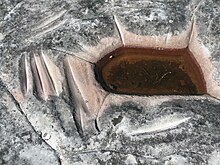
A grindstone, also known as grinding stone, is a sharpening stone used for grinding or sharpening ferrous tools, used since ancient times. Tools are sharpened by the stone's abrasive qualities that remove material from the tool through friction in order to create a fine edge. Similar to sandpaper, each stone has a different grit that will result in sharper or duller tools. In Australia, Aboriginal peoples created grinding grooves by repeated shaping of stone axes against outcrops of sandstone.
History and description
Grindstones have been used since ancient times, to sharpen tools made of metal. They are usually made from sandstone.
Grinding grooves

Aboriginal grinding grooves, or axe-grinding grooves, have been found across the Australian continent. The working edge of the hatchet or axe was sharpened by rubbing it against an abrasive stone, eventually leading to the creation of a shallow oval-shaped groove over time, The grooves vary in length from 80 mm (3.1 in) up to 500 mm (20 in), and can be up to 200 mm (7.9 in) wide and 100 mm (3.9 in) deep. They are often found near water, which was sprinkled on the stone during grinding to reduce dust.
Machines

Grindstone machines work by spinning a circular piece of stone around its center point. These machines usually have pedals for speeding up and slowing down the stone to control the sharpening process. The earliest known representation of a rotary grindstone, operated by a crank handle, is found in the Carolingian manuscript known as the Utrecht Psalter. This pen drawing from about 830 goes back to a late antique original. The Luttrell Psalter, dating to around 1340, describes a grindstone rotated by two cranks, one at each end of its axle. Around 1480, the early medieval rotary grindstone was improved with a treadle and crank mechanism.
See also
References
- Grindstones, archived from the original on 2006-01-17, retrieved 2010-02-10.
- Knight, Edward Henry (1876), Knight's American mechanical dictionary, Houghton, Mifflin, pp. 1022–1023.
- ^ "Fact sheet: Aboriginal axe-grinding grooves". First Peoples – State Relations. Victorian Government. Retrieved 21 October 2021.
- ACT Heritage Council (June 2015). "Background information: Molonglo Valley Grinding Grooves" (PDF). Retrieved 21 October 2021.
- The meaning and origin of the expression: Keep your nose to the grindstone at The Phase Finder.
- White 1962, p. 110
- Hägermann & Schneider 1997, pp. 425f.
- White 1962, p. 111
- White 1962, p. 167
Sources
- Hägermann, Dieter; Schneider, Helmuth (1997), Propyläen Technikgeschichte. Landbau und Handwerk, 750 v. Chr. bis 1000 n. Chr. (2nd ed.), Berlin, ISBN 3-549-05632-X
{{citation}}: CS1 maint: location missing publisher (link) - White, Lynn Jr. (1962), Medieval Technology and Social Change, Oxford: At the Clarendon Press
This tool article is a stub. You can help Misplaced Pages by expanding it. |
This metalworking article is a stub. You can help Misplaced Pages by expanding it. |